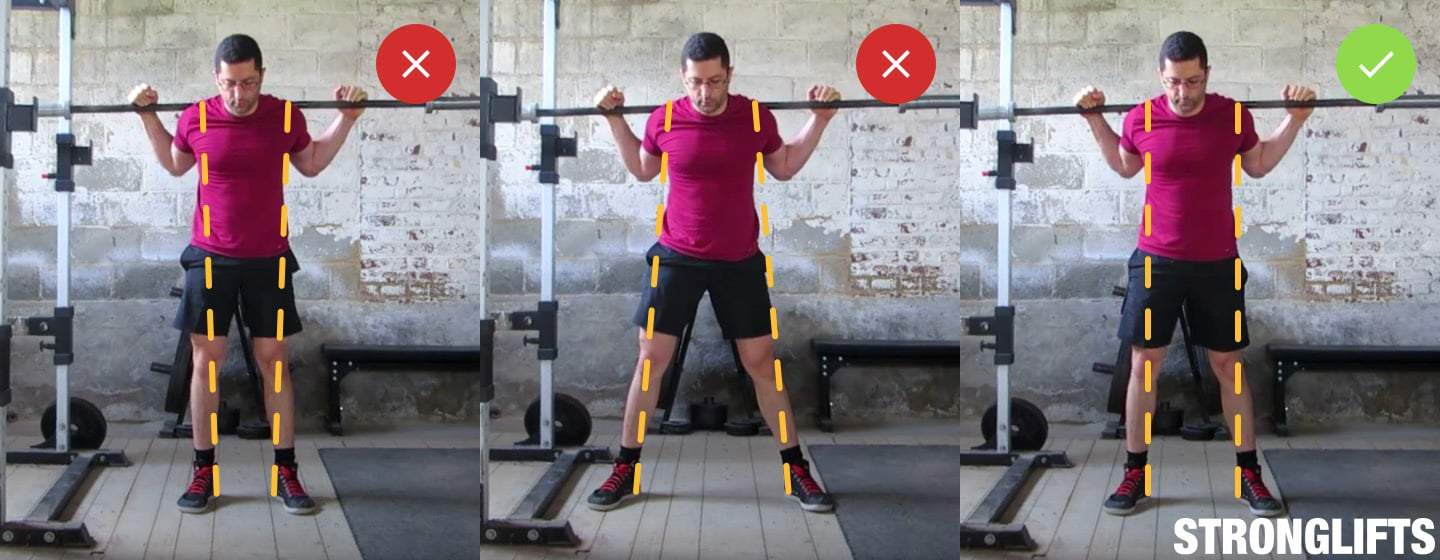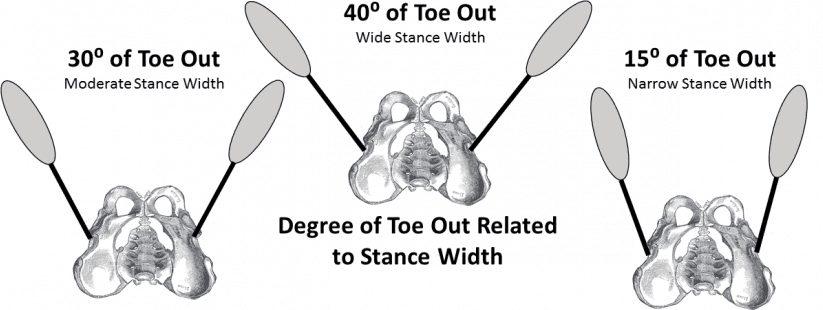Whether you do a good, strong squat is partly determined by how you place your feet. How far apart should they be and (how far) should they point outwards?
1. The ideal squat position does not exist, because it partly depends on a person’s physique. That is why one can squat ‘ass-to-grass’ without any problems and the other can sink a little less deeply (while maintaining correct form).
2. The ideal positioning of the feet, the foundation of the squat, also differs from person to person.
3. You’re standing correctly if you can complete a full range of motion (so at least to slightly below parallel), feel the most tension in your quadriceps (the target muscle after all) and not experiencing any uncomfortable feeling in your joints.
4. In practice, this usually means that you use a medium-wide stance, meaning that your heels are more or less directly under your shoulders. Your feet point outwards about 30 degrees. For many, this is the positioning in which they can perform the exercise most effectively and therefore the strongest.
5. However, don’t be afraid to experiment and experience which position works best for you.
6. Avoid a very wide or very narrow foot position.
THE IDEAL SQUAT POSITION DOES NOT EXIST
First of all this. The best way to perform a technically quite complex full-body exercise such as the barbell squat partly depends on your physique. What is optimal for one may not be for another. The ideal execution of the squat does not exist.
A good example is the question of whether you should squat ‘ass-to-the-grass’, i.e. with a full range of motion, with your butt touching the floor. The answer is yes, but only if you can maintain correct form. The latter means that you should not round at the bottom of your back, which, after all, poses an injury risk. Moreover, you often have to lose strength because your back is the weakest link.
Some tend to round the back much more quickly because they have limited ankle and hip flexibility and (ergo) limited mobility of that joint. That means that you have to work on that or that you have to squat less deeply. The latter is also fine, as long as you go at least slightly beyond parallel.
FOOTSTAND CHECKLIST
Now to the position of the feet. This forms the foundation of your squat and partly determines how well and strong you can perform the exercise. Because with a squat, your whole body actually acts like a chain, with each link affecting the total movement.
The best position for the foot position also depends on the person. But even then you can do an optimal squat in several positions, although the differences between those positions are of course subtle.
Coach Mike Israetel does not so much dictate a certain stance, but advises you to use the following checklist to determine whether you are in good standing:
- Can you handle a full range of motion (at least slightly beyond parallel) with correct form (i.e. without rounding your back and/or letting your toes come up)?
- Do you feel the exercise mainly in your quadriceps (normally the primary target muscle of the exercise)?
- Does the exercise feel comfortable on your joints (knees, ankles, and hips)?
If you can answer all three questions with ‘yes’, then your foot position is fine.
ANYWAY, SOME GUIDELINES
We understand that you would also like to receive some concrete instructions for how best to place your feet in principle, so that you can move them around a bit from there.
The foot position for the squat concerns on the one hand the width and on the other hand (resulting from this) whether and to what extent your feet point outwards.
WIDTH
The correct width does not come down to millimeters and not even centimeters. But for most, shoulder width is a good starting point, meaning the heels are directly under your shoulders. That is also the width Stronglifts.com recommends.
 Usually a medium-wide foot position works best for squats. (Source: Stronglifts)
Usually a medium-wide foot position works best for squats. (Source: Stronglifts)But don’t you sometimes see the squat performed with a very wide foot position? That’s right and in principle it is not wrong, but with such a ‘sumo squat’ you put the training emphasis on your adductors and the inner thighs. That goes against point 2 of the checklist: you primarily want to train your quads. The sumo squat is therefore simply another exercise, which is not so friendly to your groin. So it’s better to leave that sumo stand out altogether.
Also, a very narrow position is usually not ideal: your stomach will probably not have enough room to get past your legs.
DIRECTION
The vast majority of coaches recommend that the feet point slightly outwards and not straight forward. Your knees will then automatically point outward as you sink, aligning your feet with your hips and thighs.
If you let your feet point forward, it demands more of your mobility. After all, they are no longer in line with your hips and thighs. Perhaps a nice challenge, but it comes at the expense of the amount of weight you can squat.
It is not without reason that most great powerlifters use something of ‘foot flare’, as was once apparent from an inventory by coach Bret Contreras.
From a bodybuilding perspective, less weight means you have a less effective growth stimulus.
How far out should your feet point? That again depends on your stand width. The larger it is, the greater the angle at which you stick your toes out. In most cases, that will be around 30 degrees:
 With a medium-wide foot position, your toes should point out at an angle of about 30 degrees. (Source: Barbell Rehab)
With a medium-wide foot position, your toes should point out at an angle of about 30 degrees. (Source: Barbell Rehab)However, don’t be afraid to experiment and experience which position works best for you.
IN SUMMARY
The ideal squat position does not exist, because it partly depends on a person’s physique. That is why one can squat ‘ass-to-grass’ without any problems and the other can sink a little less deeply (while maintaining correct form).
The ideal positioning of the feet, the foundation of the squat, also differs from person to person.
You’re standing correctly if you can complete a full range of motion (so at least to slightly below parallel), feel the most tension in your quadriceps (the target muscle after all) and not experiencing any uncomfortable feeling in your joints.
In practice, that usually means that you use a medium-wide stance, meaning that your heels are more or less directly under your shoulders. Your feet point outwards about 30 degrees. For many, this is the positioning in which they can perform the exercise most effectively and therefore the strongest.
However, don’t be afraid to experiment and experience which position works best for you.
Avoid a very wide or very narrow foot position.